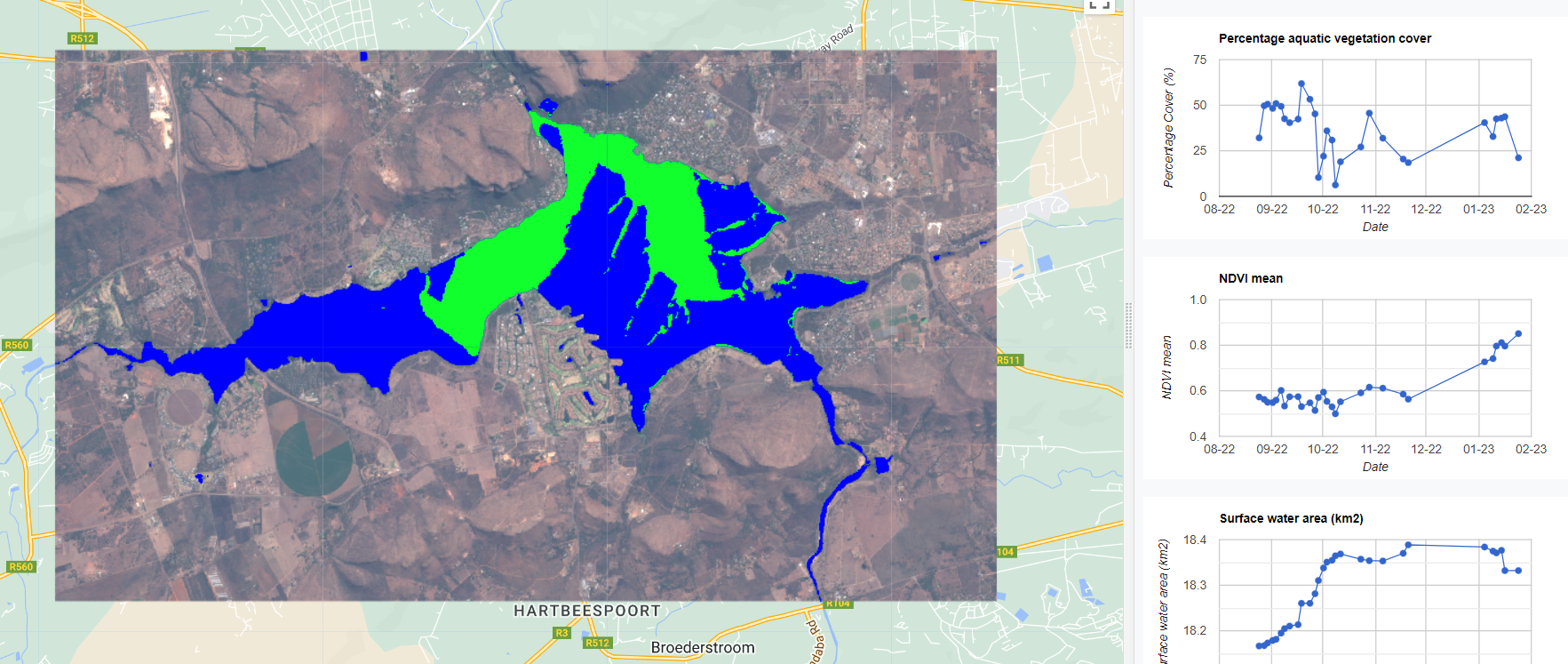
Monitor Water and Aquatic vegetation.
Access the application (Aquatic Vegetation watch) and find out more about how to use the application.
Learn moreThe application of machine learning methods to satellite data for the management of invasive water hyacinth.
Summary Biological invasions are responsible for some of the most devastating impacts on the world’s ecosystems, with freshwater ecosystems among the worst affected. Invasions not only threaten freshwater biodiversity, but also the provision of ecosystem services. Tackling the impact of invasive aquatic alien plant (IAAP) species in freshwater systems is an ongoing challenge. In the case of water hyacinth (Pontederia crassipes, previously Eichhorniae crassipes), the worst IAAP presents a long-standing management challenge that requires detailed and frequently updated information on its distribution, the context that influences its occurrence, and a systematic way to identify effective biocontrol release events. This is particularly urgent in South Africa, where freshwater resources are scarce and increasingly pressured.
In this research, I employ recent advances in machine learning (ML), remote sensing and cloud computing to improve the chances of successful water hyacinth management. This is achieved by (i) mapping the occurrence of water hyacinth across a large extent, (ii) identifying the factors that are likely driving the occurrence of the weed at multiple scales, from a waterbody level to a national extent and (iii) lastly, identifying periods for effective biocontrol release. As a result, I demonstrate the capacity of these tools to facilitate wide-scale, consistent, automated, pre-emptive, data-driven, and evidence-based decision making for managing water hyacinth.
The first chapter is a general introduction to the research problem and research questions. In the second chapter, I combine a novel image thresholding method for water detection with an unsupervised method for aquatic vegetation detection and a supervised random forest model in a hierarchical manner to localise and discriminate water hyacinth from other IAAP’s at a national extent. The value of this work is marked by the comparison of the user (87%) and producer accuracy (93%) of the introduced method to previous small-scale studies. As part of this chapter, I also show the sensor-agnostic and temporally consistent capability of the introduced hierarchical approach to monitor water and aquatic vegetation using Sentinel-2 and Landsat-8 for long periods (from 2013 - present). Lastly, this work demonstrates encouraging results when using a Deep Neural Network (DNN) to directly detect aquatic vegetation and circumvents the need for accurate water extent data. Next, I introduce two applications that build off the South African water hyacinth distribution and aquatic vegetation time series (derived in Chapter 2) in Chapter 3 and 4 respectively (described below).
In the third chapter, I use a species distribution model (SDM) that links climatic, socio-economic, ecological, and hydrological conditions to the presence/absence of water hyacinth across South Africa at a waterbody level. Thereafter, I apply explainable AI (xAI) methods (specifically SHapley Additive exPlanations or SHAP) to better understand the factors that are likely driving the occurrence of water hyacinth. The analyses of 82 (out of a 140 considered) variables shows that the most common group of drivers primarily associated with water hyacinth occurrence across South Africa are climatically related (42%). This is followed by natural land cover categories (33%) and socio-economic variables (14%), which include artificial land-cover. The two least influential groups are hydrological variables (7%) including water seasonality, runoff, and flood risk, and ecological variables (4%) including riparian soil conditions and interspecies competition. These results suggest the importance of considering landscape context when prioritising the type (mechanical, biological, chemical, or integrated) of weed management to use.
In the fourth chapter, I estimate 70-day open water proportion post-release as a reward for effective biocontrol to enable the prioritisation of suitable biocontrol release dates. This enabled the simulation of the effect of synthetic biocontrol release events under a multiarmed bandit framework for the identification of two effective biocontrol release periods (late February to mid-March and mid-November). The former was estimated to result in an 8-27% higher 70-day average open-water cover post-release in comparison to actual biocontrol release events during the study period (May 2018 - July 2020). As a case study, I show results for Hartbeespoort dam, South Africa, which could suggest improvements to the pre-existing management strategy used during the biocontrol of water hyacinth.
The novel frameworks introduced in this work go a long way in advancing IAAP species management in the age of both ongoing drives towards the adoption of artificial intelligence and sustainability for a better future. It goes beyond (i) traditional small-scale and infrequent mapping, (ii) standard SDMs, to now include the benefits of spatially explicit model explainability and (iii) introduces a semi-automated and widely applicable method to explore potential biocontrol release events. The direct benefit of this work, or indirect benefits from derivative work outweighs both the low production costs or equivalent field and lab work.
To improve the adoption of modern ML and EO tools for invasive species management, I have made the developed tools publicly accessible. In addition, a human-AI symbiosis that combines strengths and compensates for weaknesses is strongly recommend. For each application, I also provide directions for future research based on the drawbacks and limitations of the introduced systems. These future efforts will likely increase the adoption of EO-derived products by water managers and improve the reliability of these products.
This webpage provides information for users to access the tools developed during the PhD research. Refer to posts below for more information

Access the application (Aquatic Vegetation watch) and find out more about how to use the application.
Learn more
Code used to create the application and research code.
Click here
Find out where this research is headed.
Learn more